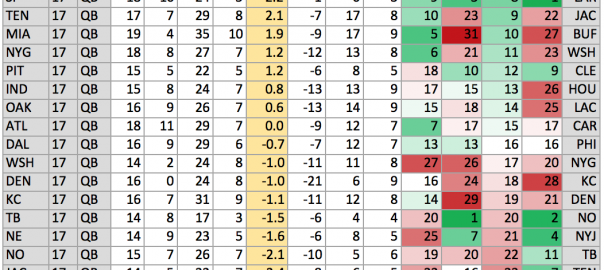Below is a table of our NBA Elo ratings for the 2018-2019 season along with win totals and playoff probabilities derived from 500 simulations of the 2018-2019 season. Check back over the course of the season as we will continue to update our elo ratings, along with win projections and playoff probabilities.
Elo ratings are a zero-sum rating system where teams are rewarded points after a win and subtracted points after a loss. The magnitude of this adjustment is larger for more unexpected outcomes. For instance, the Golden State Warriors would not receive much of a boost in their elo if they beat the Phoenix Suns because this is what we would expect to happen, but the Phoenix Suns would receive a larger increase in their elo if they managed to upset the Warriors. At Model284, our elos take into account each team’s prior elo rating, margin of victory, home court advantage, and the number of days off for each team prior to the game. Elo ratings do not immediately adjust for injuries, or roster changes from free agency and trades.
| Team | Elo | Wins | Playoff Probability |
| Milwaukee Bucks | 1744 | 60.8 | >0.99 |
| Golden State Warriors | 1706 | 56.7 | >0.99 |
| Houston Rockets | 1706 | 52.6 | >0.99 |
| Portland Trail Blazers | 1675 | 52.2 | >0.99 |
| Toronto Raptors | 1658 | 57.3 | >0.99 |
| Utah Jazz | 1649 | 50.2 | >0.99 |
| Philadelphia 76ers | 1646 | 53.2 | >0.99 |
| Denver Nuggets | 1629 | 54.1 | >0.99 |
| Los Angeles Clippers | 1598 | 49.2 | >0.99 |
| San Antonio Spurs | 1596 | 47.3 | >0.99 |
| Orlando Magic | 1574 | 41 | 0.83 |
| Oklahoma City Thunder | 1542 | 46.5 | >0.99 |
| Detroit Pistons | 1541 | 42.7 | 0.99 |
| Boston Celtics | 1528 | 47.5 | >0.99 |
| Indiana Pacers | 1517 | 47.9 | >0.99 |
| Miami Heat | 1515 | 40.3 | 0.42 |
| Brooklyn Nets | 1495 | 40.9 | 0.75 |
| Los Angeles Lakers | 1469 | 36.5 | <0.01 |
| Minnesota Timberwolves | 1459 | 36.6 | <0.01 |
| Sacramento Kings | 1457 | 40.3 | <0.01 |
| Charlotte Hornets | 1453 | 37.2 | 0.01 |
| Washington Wizards | 1414 | 34.4 | <0.01 |
| Atlanta Hawks | 1373 | 29.1 | <0.01 |
| Memphis Grizzlies | 1372 | 32.5 | <0.01 |
| New Orleans Pelicans | 1365 | 33.5 | <0.01 |
| Dallas Mavericks | 1360 | 32.7 | <0.01 |
| Chicago Bulls | 1302 | 22.8 | <0.01 |
| Cleveland Cavaliers | 1293 | 20.4 | <0.01 |
| Phoenix Suns | 1201 | 18.3 | <0.01 |
| New York Knicks | 1175 | 15.4 | <0.01 |
*Last update on April 1st.
